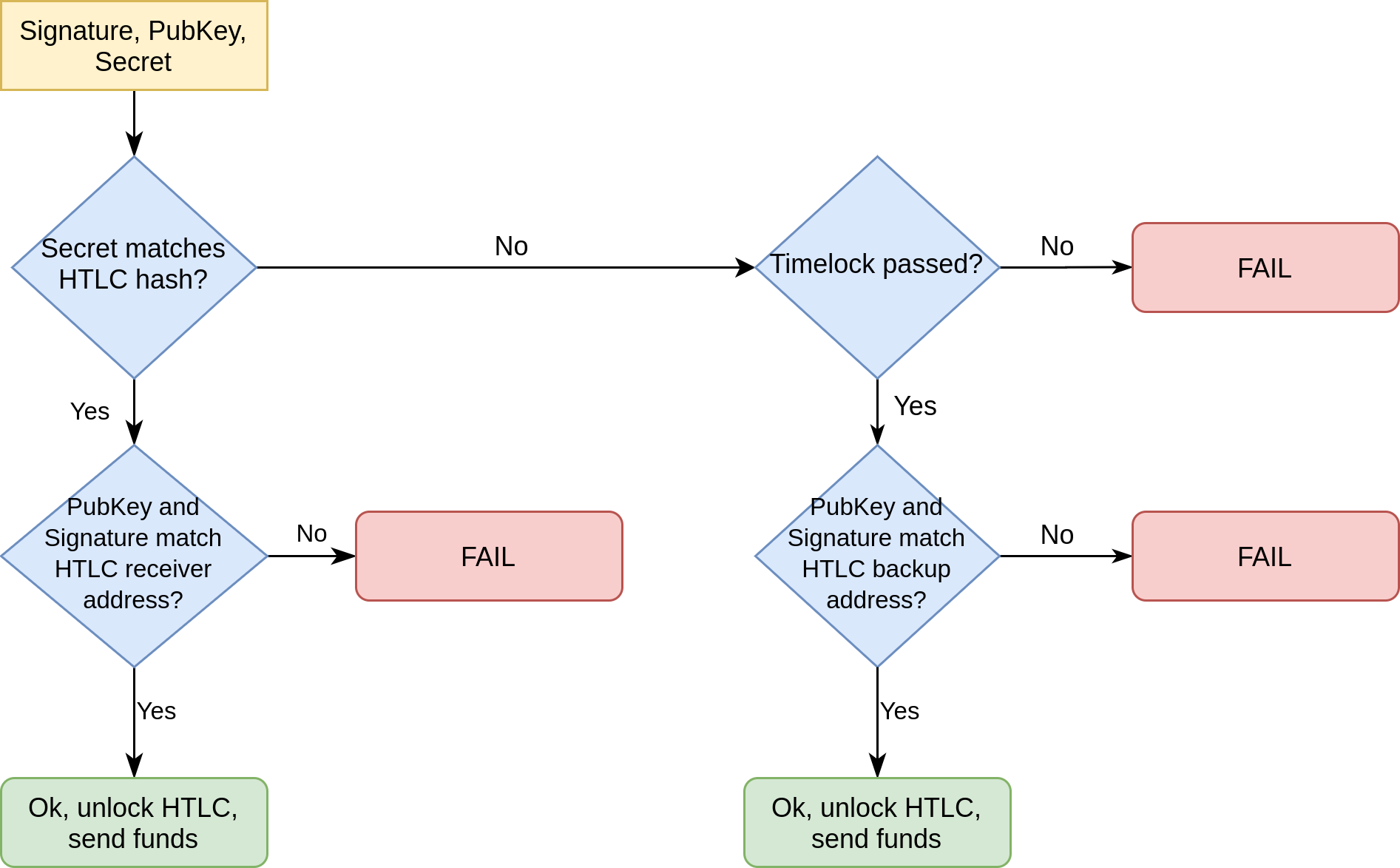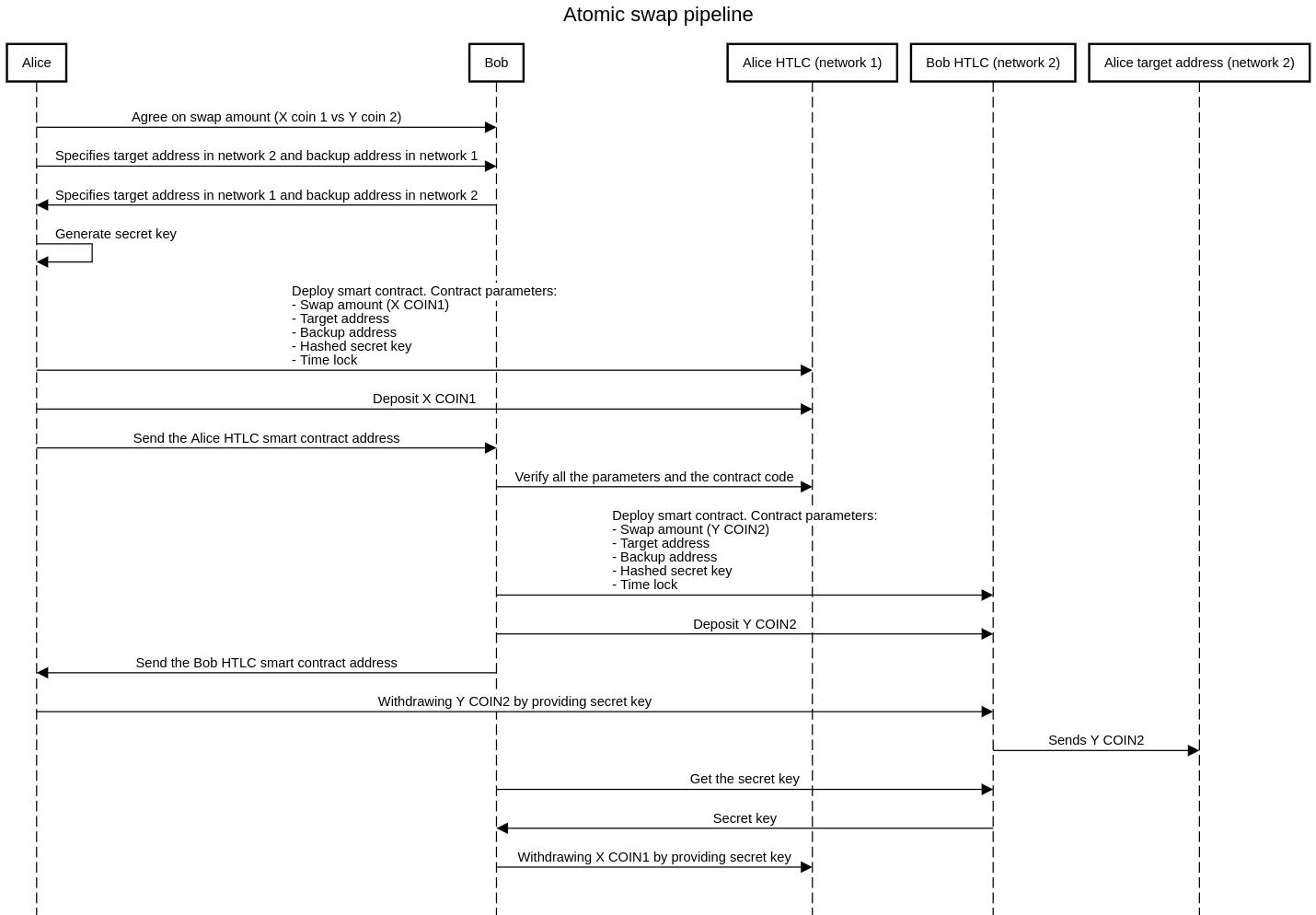This repo contains the list of smart contracts and additional tools, which allows anyone to perform atomic swaps with assets, issued on the following blockchains:
- Ethereum
- TON
- Bitcoin
Besides the smart contracts, are also available documentation, tests, FAQ and video tutorials. More specifically, you can use the provided toolbox for exchanging the following assets:
- ETH
- BTC
- Crystal
- Any ERC20 tokens, issued on the Ethereum network (DAI, USDT, LINK, etc)
The whole idea is based on the well-known HTLC contracts, where HTLC means "Hashed Timelock Contract". This section explains this concept in a simple terms.
Let's imagine that we have two independent networks and each network has an asset used in it. On the picture bellow first network's asset is called COIN1 and the second network's asset is called COIN2. Also, there're two actors - Alice, who has X COIN1 and Bob, who has Y COIN2. Imagine, that Alice and Bob agreed to exchange their assets with X / Y rate. How can they do this without involving the third party?
The HTLC contract can solve this problem. The idea is to lock the assets on the special smart contract with some secret key. After assets are locked, they can be revealed in only two ways:
- By providing the secret key. In this case, assets are send on the pre-defined address (target address).
- If the secret key wasn't provided in within the pre-defined time period. In this case, assets are send to the pre-defined address (backup address).
First of all, Alice and Bob agree on the following:
-
Alice sends her X COIN1 in exchange for Y COIN2 and vice versa for Bob
-
Alice provides one address for receiving COIN2 and another address for refunding her COIN1 in case the deal falls through. Bob do the same vice versa.
-
Alice imagine some long hard-to-guess secret. After that she creates the HTLC smart contract with the following details:
- Swap amount - How much COIN1 should be locked
- Target address (aka targetBob) - On which address COIN1 should be send in case of successful swap (Address controlled by Bob)
- Backup address (aka backupAlice) - On which address COIN1 should be send in case the deal falls through (Address controlled by Alice)
- Hashed secret key - the hash of the secret key. At the time of creating the contract, this key is known only to Alice
- Time lock - how long must it take before Alice can collect the money back, in case no one provided the correct secret key. Let's say the time lock is equal to 48 hours.
-
Alice deposit the X COIN to the smart contract and send the smart contract address to Bob
-
Since the data in the blockchain is available to everyone, Bob verifies the Alice's smart contract.
-
Bob extracts the Hashed secret key from the Alice's smart contract and also creates HTLC contract with the following parameters:
- Amount - How much COIN2 should be locked
- Target address (aka targetAlice) - On which address COIN2 should be send in case of successful swap (Address controlled by Alice)
- Backup address (aka backupBob) - On which address COIN2 should be send in case the deal falls through (Address controlled by Bob)
- Hashed secret key - the hash, specified by the Alice in her HTLC contract
- Time lock - how long must it take before Bob can collect the money back, in case no one provided the correct secret key. Important: the Bob's time lock should expire earlier than Alice's. Let's it's equal to the 24 hours.
-
Bob deposit the Y COIN2 to the smart contract and send the smart contract address to Alice
-
Alice unlocks the Bob's smart contract by using her secret key. Since Bob used the correct hash, Alice secret key should fit and Y COIN2 will be sent to the targetAlice.
-
Since the data in the blockchain is available to everyone, Bob can see the Alice gets his Y COIN2. And what is more important - Bob can get the secret key from the blockchain. With that secret key, Bob unlocks the Alice's smart contract and receives the X COIN1 to his targetBob address.
In this case Alice need to wait until the time lock expires (in our case it's 48 hours). After that, she can claim a refund - X COIN1 will be sent to the backupAlice. Since the secret key is known only to Alice, no one could claim her assets during this period.
In this case Bob need to wait until the time lock expires (in our case it's 24 hours). After that, he can claim a refund - Y COIN2 will be sent to the backupBob. Since the secret key is known only to Bob, no one could claim his assets during this period.
Short answer - no. Long answer - it depends on Bob. Since the Alice's lock time is less than Bob's (24 vs 48 hours), Alice need to wait longer the refund her assets.
If you're trying to reproduce the video tutorials or run the tests or update the source code, you need to install some dependencies.
$ node --version
v10.21.0
$ npm --version
6.14.8
$ npm install
The HTLC idea fits perfectly with EVM smart contracts, so the implementation for Ethereum side isn't the hardest part. Basically, there're two smart contracts for Ethereum network - AtomicSwapETH and AtomicSwapERC20. First one should be used for working with native ETH token, and second one supports any ERC20 token. The smart contract's source code is written in Solidity. All the code can be found at /src/ethereum-contracts/contracts.
$ cd src/ethereum/contracts
$ truffle compile
There're automatic Truffle tests, that covers the ETH / ERC20 atomic swap contracts on Ethereum. The easiest way to run this tests, is to run the Ganache and then start the Truffle tests.
$ ganache-cli -e 200 -a 10
$ # Run tests at another terminal
$ cd src/ethereum/contracts
$ truffle test
Important: to test the refund functionality, you should be able to manipulate the blockchain time. So, running this tests on the Mainnet / Ropsten / etc networks probably won't work.
At this section you can find an instruction for working with Ethereum HTLC contracts (ETH and ERC20 version). All the interactions are implemented in form of cli application at src/ethereum-contracts/scripts/htlc-cli.js. This CLI allows you to:
- Deploy HTLC contract
- Get the parameters and status of the HTLC contract
- Withdraw from the HTLC contract, by providing the secret key
All the configuration for using the HTLC contract over the Ethereum network should be placed in the /src/ethereum-contracts/.env file. Copy & paste the template bellow and fill it with your details.
ETHEREUM_NODE_RPC=
ETHEREUM_PRIVATE_KEY=
ETHEREUM_NETWORK_ID=
ETHEREUM_GAS_PRICE=
ETHEREUM_HTLC_TARGET_ADDRESS=
ETHEREUM_HTLC_BACKUP_ADDRESS=
ETHEREUM_HTLC_PLATFORM_ADDRESS=
ETHEREUM_HTLC_SWAP_AMOUNT=
ETHEREUM_HTLC_FEE_AMOUNT=
ETHEREUM_HTLC_TIME_LOCK=
ETHEREUM_HTLC_SECRET_HASH=
ETHEREUM_HTLC_TOKEN_ADDRESS=
ETHEREUM_HTLC_ADDRESS=
ETHEREUM_HTLC_SECRET_RAW=
Important: Specify ETHEREUM_HTLC_TOKEN_ADDRESS in case you deploying HTLC swap for ERC20 token. Leave it blank for ETH swap.
- Specify all environment parameters, except
ETHEREUM_HTLC_ADDRESSandETHEREUM_HTLC_SECRET_RAW. - Deploy the smart contract
$ cd src/ethereum-contracts/
$ # Deploy HTLC contract for ETH swap
$ truffle exec scripts/htlc-cli.js --network env --command deploy-htlc --htlc-type eth
$ # Deploy HTLC contract for ERC20 swap
$ truffle exec scripts/htlc-cli.js --network env --command deploy-htlc --htlc-type erc20
- Specify the
TON_HTLC_ADDRESSwith the address, received at deploy step - Get all the details from the smart contract
$ cd src/ethereum-contracts/
$ # Get details for ETH swap
$ truffle exec scripts/htlc-cli.js --network env --command get-details --htlc-type eth
$ # Get details for ERC20 swap
$ truffle exec scripts/htlc-cli.js --network env --command get-details --htlc-type erc20
- Specify the raw secret key at the
ETHEREUM_HTLC_SECRET_RAW - Send the withdraw transaction
$ cd src/ethereum-contracts/
$ # Withdraw ETH swap
$ truffle exec scripts/htlc-cli.js --network env --command withdraw --htlc-type eth
$ # Withdraw ERC20 swap
$ truffle exec scripts/htlc-cli.js --network env --command withdraw --htlc-type erc20
TON network also support smart contracts, but the TVM implementation differs from the EVM. So HTLC smart contract is slightly different from the Ethereum's one. The smart contracts is written in Solidity, by using the TON labs Solidity compiler.
To update the contract source, you should install TON Solidity compiler and tvm linker.
$ cd src/ton-contracts/contracts;
$ solc HTLC-Crystal.sol
$ tvm_linker compile HTLC-Crystal.code --lib <REPLACE_WITH_YOUR_PATH>/TON-Solidity-Compiler/lib/stdlib_sol.tvm
All the configuration for using the HTLC contract over the TON network should be placed in the /src/ton-contracts/.env file. Copy & paste the template bellow and fill it with your details.
TON_HTLC_TVC=contracts/1893ca442d590d1a122b170e52c69d1937cc82538bcfd83c4c2caa7a2ad20873.tvc
TON_HTLC_ABI=contracts/HTLC-Crystal.abi.json
TON_SECRET_KEY=
TON_PUBLIC_KEY=
TON_SERVER=https://main.ton.dev
TON_HTLC_TARGET_ADDRESS=
TON_HTLC_BACKUP_ADDRESS=
TON_HTLC_PLATFORM_ADDRESS=
TON_HTLC_SWAP_AMOUNT=
TON_HTLC_FEE_AMOUNT=
TON_HTLC_TIME_LOCK=
TON_HTLC_SECRET_HASH=
TON_HTLC_ADDRESS=
TON_HTLC_SECRET_RAW=
At this section you can find an instructions for working with TON HTLC smart contract. Using this toolbox, you can:
- Deploy HTLC contract
- Get the parameters and status of the HTLC contract
- Withdraw from the HTLC contract, by providing the secret key
- Refund from the HTLC contract, after the time lock expires
- Specify all environment parameters, except
TON_HTLC_ADDRESSandTON_HTLC_SECRET_RAW - Deploy the smart contract
$ cd src/ton-contracts/
$ node scripts/deploy.js
- Specify the
TON_HTLC_ADDRESSwith the address, received at deploy step - Get all the details from the smart contract
$ cd src/ton-contracts/
$ node scripts/get-htlc-details.js
- Specify the raw secret key at the
TON_HTLC_SECRET_RAW - Send the withdraw message
$ cd src/ton-contracts/
$ node scripts/withdraw.js
Bitcoin is not capable of running fully functional smart-contracts, nevertheless bitcoin script is enough for implementing HTLC contract. Below you can see implementation written in script, which is an array of opcodes:
# check if given secret is preimage of secret_hash set in HTLC
OP_SHA256, secret_hash, OP_EQUAL
OP_IF
# check if person, who revealed secret is intended payee
OP_DUP, OP_HASH160, receiver_hashed_pubkey, OP_EQUALVERIFY, OP_CHECKSIG
OP_ELSE
# check if timelock passed
timelock_hex, OP_CHECKLOCKTIMEVERIFY, OP_DROP
# check that person that requested refund is original payer
OP_DUP, OP_HASH160, backup_hashed_pubkey, OP_EQUALVERIFY, OP_CHECKSIG
OP_ENDIF
To unlock it, receiver should provide unlocking script with following structure:
signature, pubKey, secret
And to make a refund, owner of backup address should provide next script after timelock passed:
signature, pubKey, wrong_secret
Its logic can be visualized in a flowchart:

At this section you can find an instruction for working with Bitcoin HTLC contracts. All the interactions are implemented in form of cli application at src/bitcoin-contracts This CLI allows you to:
- generate address (p2wpkh address)
- generate HTLC contract address (p2sh address)
- redeem HTLC contract (receiver)
- redeem HTLC contract (backup)
$ node generate_addr.js
-------
WIF private key: cNRf95wXxCpiTbEZVaTZm399qgS6EDLPCPj8XCLe7U5thSuu3VGr
Bitcoin Testnet address (native segwit): tb1qp5svaqlq6c6cajxvtcyhmtu80ysk99cjmcc4n7
node generate_htlc.js\
--secret <secret hex>\
--receiver <addr1>\
--payer <addr2>\
--timelock <now + 24/48h timestamp>
-------
secret hash <secret hash hex>
Redeem script - <redeem script hex>
P2SH addr - <p2sh addr>
$ node redeem_htlc.js\
--key <WIF private key of receiver addr of htlc>\
--tx_id <input tx hash>\
--index <output num in input tx that we spend>\
--receiver <receiver addr>\
--out_value <output value>\
--prev_tx <input tx hex>\
--redeem <redeem script hex>\
--secret <secret to unlock htlc>
-------
Redeem tx hex:
<tx hex>
$ node redeem_htlc_backup.js\
--key <WIF private key of backup addr of htlc>\
--tx_id <input tx hash>\
--index <output num in input tx that we spend>\
--receiver <receiver addr>\
--out_value <output value>\
--prev_tx <input tx hex>\
--redeem <redeem script hex>
-------
Redeem tx hex:
<tx hex>

